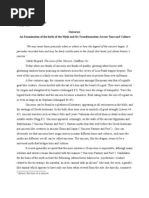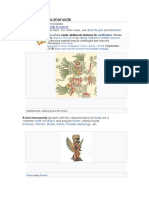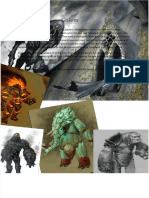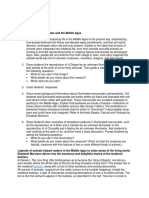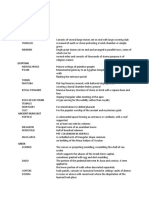Manticore: Adding Citations To Reliable Sources
Manticore: Adding Citations To Reliable Sources
Uploaded by
Cindy PietersCopyright:
Available Formats
Manticore: Adding Citations To Reliable Sources
Manticore: Adding Citations To Reliable Sources
Uploaded by
Cindy PietersOriginal Description:
Original Title
Copyright
Available Formats
Share this document
Did you find this document useful?
Is this content inappropriate?
Copyright:
Available Formats
Manticore: Adding Citations To Reliable Sources
Manticore: Adding Citations To Reliable Sources
Uploaded by
Cindy PietersCopyright:
Available Formats
Manticore
From Wikipedia, the free encyclopedia
For other uses, see Manticore (disambiguation).
This article needs additional citations for verification. Please help improve this article by adding citations to reliable sources. Unsourced material may be challenged and removed. (June 2012)
Manticore (1678)
Grouping
Legendary creatures
Sub grouping
Mythological hybrids
Similar creatures
Sphinx
Mythology
Eurasian
The manticore (Early Middle Persian Martyaxwar) is a Persian legendary creature similar to the Egyptian sphinx. It has the body of a red lion, a human head with three rows of sharp teeth (like a shark), sometimes bat wings, and a trumpet-like voice. Other aspects of the creature vary from story to story. It may be horned, winged, or both. The tail is that of either a dragon or a scorpion, and it may shoot poisonous spines to either paralyze or kill its victims. It devours its prey whole and leaves no clothes, bones, or possessions of the prey behind.
Contents
[hide]
1 Origin 2 Medieval and post-medieval appearances 3 In art and literature 4 References
5 External links
Origin[edit]
The manticore myth was of Persian origin, where its name was "man-eater" (from early Middle Persian martya "man" (as in human) and xwar- "to eat"). The English term "manticore" was borrowed from Latin mantichora, itself derived from the Greek rendering of the Persian name, , martichora. It passed into European folklore first through a remark by Ctesias, a Greek physician at the Persian court of King Artaxerxes II in the fourth century BC, in his book Indica ("India"), which circulated among Greek writers on natural history but has survived only in fragments, or references by those other writers. The Romanised Greek Pausanias, in his Description of Greece, recalled strange animals he had seen at Rome and commented, The beast described by Ctesias in his Indian history, which he says is called martichora by the Indians and "man-eater" (androphagos) by the Greeks, I am inclined to think is thetiger. But that it has three rows of teeth along each jaw and spikes at the tip of its tail with which it defends itself at close quarters, while it hurls them like an archer's arrows at more distant enemies; all this is, I think, a false story that the Indians pass on from one to another owing to their excessive dread of the beast. (Description, xxi, 5) Pliny the Elder did not share Pausanias' skepticism. He followed Aristotle's natural history by including the martichorasmistranscribed as manticorus in his copy of Aristotle and thus passing into European languagesamong his descriptions of animals in Naturalis Historia, c. 77 AD. Later, in The Life of Apollonius of Tyana Greek writer Flavius Philostratus (c. 170247) wrote: And inasmuch as the following conversation also has been recorded by Damis as having been held upon this occasion with regard to the mythological animals and fountains and men met with in India, I must not leave it out, for there is much to be gained by neither believing nor yet disbelieving everything. Accordingly Apollonius asked the question, whether there was there an animal called the man-eater (martichoras); and Iarchas replied: "And what have you heard about the make of this animal? For it is probable that there is some account given of its shape." "There are," replied Apollonius, "tall stories current which I cannot believe; for they say that the creature has four feet, and that his head resembles that of a man, but that in size it is comparable to a lion; while the tail of this animal puts out hairs a cubit long and sharp as thorns, which it shoots like arrows at those who hunt it."[1]
Manticore in an illustration from theRochester Bestiary (c.1230-1240)
Manticore or mantyger badge of William, Lord Hastings, c.1470. Note that this version has tusks.
Medieval and post-medieval appearances[edit]
Pliny's book was widely enjoyed and uncritically believed through the European Middle Ages, during which the manticore was sometimes described or illustrated in bestiaries. Through false etymology, it was sometimes assumed that the name was an amalgamation of man and tiger;[2] although other sources regarded the mantyger as a different creature entirely (the mantyger having monkey-like feet, being apparently inspired by the baboon; and also sometimes being represented with either tusks or short horns).[3] There was further confusion as to whether the manticore should be identified with or distinguished from the satyral and the lampago.[4] The manticore or mantyger first appeared in English heraldry in c.1470, as a badge of William Hastings, 1st Baron Hastings; and in the 16th century it was used as a badge by Robert Radcliffe, 1st Earl of Sussex, and by Sir Anthony Babyngton.[5] Randle Holme in 1688 described the manticore (which he regarded as distinct from the mantyger) as having the face of a man, the mouth open to the ears with a treble row of teeth beneath and above; long neck, whose greatness, roughness, body and feet are like a Lyon: of a red colour, his tail like the tail of a Scorpion of the Earth, the end armed with a sting, casting forth sharp pointed quills.[6]
The heraldic manticore influenced some Mannerist representations, as in Bronzino's allegory The Exposure of Luxury (National Gallery, London)[7]but more often in the decorative schemes called "grotteschi"of the sin of Fraud, conceived as a monstrous chimera with a beautiful woman's face, and in this way it passed by means of Cesare Ripa's Iconologia into the seventeenth and eighteenth century French conception of a sphinx.
In art and literature[edit]
Canadian writer Robertson Davies wrote a novel titled The Manticore, published in 1972. It is the second volume of his Deptford Trilogy.[8]
The Manticore and Other Horrors is the tenth studio album by English extreme metal band Cradle of Filth.
In J. K. Rowling's Harry Potter series of books, the character Rubeus Hagrid somehow managed to acquire Manticores, and got them to breed with fire crabs, creating the hybrid Blast-Ended Skrewts. Hermione Granger also reads a news article about how a manticore killed someone, but was let off the hook because everyone was too scared to go near it.
Manticores appear in George R.R. Martin's A Song of Ice and Fire series, though in his universe, live manticores are scorpion-like insects with markings resembling a human face on their carapace. They are valued for their venom, which is lethal and incurable, making it a favourite poison. The mythical creature in its traditional form also appears as a heraldic device.
A Manticore appears in the Percy Jackson & the Olympians series book three by Rick Riordan. In the book, it disguises itself as a French military school teacher. Notably, it is depicted with heterochromia in its human and animal form, with orange fur. In Percy Jackson: Sea of Monsters, A Manticore (played by Daniel Cudmore) appears as Luke Castellan's henchman in place of Agrius and Oreius.
Manticores are favoured mounts of Dark Elf generals in Warhammer, being popular because of their power and aggressive nature.
A Manticore serves as a boss and later as regular enemies in the Castlevania Aria of Sorrow and Castlevania Dawn of Sorrow games. They're full lion bodied beings, with batwings and scorpion tails.
In God of War: Ascension, the Manticore appears as a boss; here it has bat wings, with the ability to breathe fire and instantly spawn smaller manticores. The protagonist, Kratos, must defeat the beast in battle in order to proceed in the game.
In the BBC series Merlin, the Manticore is depicted as a small creature with a frill like that of a frilled lizard, a humanoid head, a feline body, bat-like wings and a scorpion's tail.
In the Honor Harrington series of novels, Manticore is the name of a binary star system, its capital planet, and its associated Kingdom. The heroine, Honor Harrington, is an officer in the Royal Manticoran Navy.
The main characters of the show My Little Pony: Friendship Is Magic encounter a Manticore during the two-part Season 1 pilot. Here it is depicted as having the full body and head of a lion with bat wings, bat-like pointed ears, and a scorpion tail. It is fierce at first, but becomes friendly after Fluttershy removes a thorn in its paw (see Androcles).
The musical duo Ninja Sex Party has made a song entitled Manticore. [9] In the 2008 film Princess, a manticore lives in the princess's care.
You might also like
- Pi-Bot V2.0 User ManualDocument110 pagesPi-Bot V2.0 User ManualMarcelo Carvalho100% (1)
- Monsters Seminar Write-UpDocument2 pagesMonsters Seminar Write-UpmallgrajNo ratings yet
- 101 Amazing Mythical Beasts: ...and Legendary CreaturesFrom Everand101 Amazing Mythical Beasts: ...and Legendary CreaturesRating: 3 out of 5 stars3/5 (5)
- The Best Werewolf Short Stories 1800-1849: A Classic Werewolf AnthologyFrom EverandThe Best Werewolf Short Stories 1800-1849: A Classic Werewolf AnthologyNo ratings yet
- RatDocument192 pagesRatsy734100% (2)
- The Unnatural History of Tolkien's OrcsDocument12 pagesThe Unnatural History of Tolkien's OrcsanctrooperNo ratings yet
- ManticoreDocument3 pagesManticoreLintokNo ratings yet
- Roger: The Myth OF UnicornDocument23 pagesRoger: The Myth OF UnicornliviuisrNo ratings yet
- Myths CreaturesDocument4 pagesMyths CreaturesRejelle CosteloNo ratings yet
- Myth CreaturesDocument10 pagesMyth CreaturesMyka Andrea Panganiban Garcia100% (2)
- Research Paper On The History of Unicorns - For Research Use ONLYDocument12 pagesResearch Paper On The History of Unicorns - For Research Use ONLYEmily HornNo ratings yet
- Uniwho?: in AntiquityDocument3 pagesUniwho?: in AntiquityJérémie GallienNo ratings yet
- The Integrationof Mythical Creaturesinthe Harry Potter Series Terri PinyerdDocument5 pagesThe Integrationof Mythical Creaturesinthe Harry Potter Series Terri Pinyerdmohitbehera668No ratings yet
- A History of Dragons: Their Influence on Life and CultureFrom EverandA History of Dragons: Their Influence on Life and CultureNo ratings yet
- BestiaryDocument54 pagesBestiaryChrisNo ratings yet
- Animal Parallelism in Medieval LiteratureDocument14 pagesAnimal Parallelism in Medieval LiteratureHerman Give'emThe-BirdNo ratings yet
- Unicorn Occult 984391Document30 pagesUnicorn Occult 984391Elsa paparezouNo ratings yet
- A Good Dragon Is Hard To Find or From DDocument33 pagesA Good Dragon Is Hard To Find or From DMTHNo ratings yet
- The Unnatural History of Tolkien OrcsDocument12 pagesThe Unnatural History of Tolkien OrcsCallumNo ratings yet
- Rat King Entry From WikiDocument5 pagesRat King Entry From WikiWacek4444No ratings yet
- UnicornDocument90 pagesUnicornGjan SahariNo ratings yet
- Dragon: Navigation Search Dragon (Disambiguation)Document15 pagesDragon: Navigation Search Dragon (Disambiguation)manoj kumarNo ratings yet
- List of Avian HumanoidsDocument8 pagesList of Avian HumanoidsJoff Esposo50% (2)
- ADocument70 pagesAAndrea NavarroNo ratings yet
- CentaurDocument3 pagesCentaurCindy PietersNo ratings yet
- Mytical-Creatures CompressedDocument12 pagesMytical-Creatures CompressedЛион ГоровецNo ratings yet
- 10 - The Myths and Folktales Behind Harry PotterDocument2 pages10 - The Myths and Folktales Behind Harry Potterlacroix.b30No ratings yet
- Dragon: This Article Is About The Legendary Creature, Not To Be Confused With or - For Other Uses SeeDocument2 pagesDragon: This Article Is About The Legendary Creature, Not To Be Confused With or - For Other Uses SeeEduard Loberez ReyesNo ratings yet
- Medieval BestiaryDocument4 pagesMedieval BestiarymarianafartadoNo ratings yet
- The Beasts that Hide from Man: Seeking the World's Last Undiscovered AnimalsFrom EverandThe Beasts that Hide from Man: Seeking the World's Last Undiscovered AnimalsRating: 3.5 out of 5 stars3.5/5 (9)
- Adventures in Cryptozoology Volume 1: Hunting for Yetis, Mongolian Deathworms, and Other Not-So-Mythical MonstersFrom EverandAdventures in Cryptozoology Volume 1: Hunting for Yetis, Mongolian Deathworms, and Other Not-So-Mythical MonstersRating: 2 out of 5 stars2/5 (4)
- The Book of Barely Imagined Beings: A 21st Century BestiaryFrom EverandThe Book of Barely Imagined Beings: A 21st Century BestiaryNo ratings yet
- Rediscovering The Horse in Medieval French LiteratureDocument13 pagesRediscovering The Horse in Medieval French LiteratureCarmilla von KarnsteinNo ratings yet
- Carcosa - 1d4chanDocument2 pagesCarcosa - 1d4chanbedewof593No ratings yet
- Dracula’s Brood: Neglected Vampire Classics by Sir Arthur Conan Doyle, M.R. James, Algernon Blackwood and OthersFrom EverandDracula’s Brood: Neglected Vampire Classics by Sir Arthur Conan Doyle, M.R. James, Algernon Blackwood and OthersRating: 4 out of 5 stars4/5 (11)
- Tipos de FerasDocument9 pagesTipos de FerasFábio Romeiro GulloNo ratings yet
- Instant Download (Ebook) Rat (Animal) by Jonathan Burt ISBN 9781861892249, 1861892241 PDF All ChaptersDocument81 pagesInstant Download (Ebook) Rat (Animal) by Jonathan Burt ISBN 9781861892249, 1861892241 PDF All Chapterstarrawoldupp100% (1)
- Dragons of LegendDocument7 pagesDragons of LegendRobert David KeenNo ratings yet
- IN HP: Buckbeak, Later Renamed Witherwings, Was A Hippogriff. He Lived With Rubeus Hagrid During Harry Potter'sDocument5 pagesIN HP: Buckbeak, Later Renamed Witherwings, Was A Hippogriff. He Lived With Rubeus Hagrid During Harry Potter'sGCNo ratings yet
- List of Dragons in Literature - WikipediaDocument10 pagesList of Dragons in Literature - Wikipediajorge solieseNo ratings yet
- Fable - WikipediaDocument23 pagesFable - WikipediaBTS ARMYNo ratings yet
- The Real Story of Dinosaurs and Dragons: Science Sets the Fossil Record StraightFrom EverandThe Real Story of Dinosaurs and Dragons: Science Sets the Fossil Record StraightNo ratings yet
- Topic 445Document16 pagesTopic 445merita tirollariNo ratings yet
- List of Hybrid Creatures in Folklore: Partly HumanDocument11 pagesList of Hybrid Creatures in Folklore: Partly HumanSadri Gaieb100% (1)
- DragonDocument12 pagesDragonAgostefNo ratings yet
- T H 358 ks2 Famous Mythical Creatures Powerpoint - Ver - 7Document14 pagesT H 358 ks2 Famous Mythical Creatures Powerpoint - Ver - 7nadaNo ratings yet
- The Dragons of Somerset: And Their Relation to Dragons of the WorldFrom EverandThe Dragons of Somerset: And Their Relation to Dragons of the WorldNo ratings yet
- Various Occult, Tribal & Celtic ImagesDocument28 pagesVarious Occult, Tribal & Celtic Imagesufo71No ratings yet
- NS 6 - 240-260 - Eagle and Serpent in ZA - D. S. ThatcherDocument21 pagesNS 6 - 240-260 - Eagle and Serpent in ZA - D. S. ThatcherTG-DOXANo ratings yet
- Unicornicopia: Magical Creatures, A Weiser Books CollectionFrom EverandUnicornicopia: Magical Creatures, A Weiser Books CollectionRating: 2.5 out of 5 stars2.5/5 (3)
- Mythical CreaturesDocument21 pagesMythical Creaturesuswalad710No ratings yet
- Svetlana Gilot - 11 - 9 - The - Stuff - of - Legend - NonfictionDocument13 pagesSvetlana Gilot - 11 - 9 - The - Stuff - of - Legend - Nonfictionsvegilot100% (1)
- Handel's Bestiary: In Search of Animals in Handel's OperasFrom EverandHandel's Bestiary: In Search of Animals in Handel's OperasRating: 4 out of 5 stars4/5 (2)
- Fantasy LiteratureDocument11 pagesFantasy LiteratureLeonardo Alfonso Navarro BaeriswylNo ratings yet
- PreviewDocument13 pagesPreviewpejicluka38No ratings yet
- Anthropomorphism PDFDocument11 pagesAnthropomorphism PDFMarto FeNo ratings yet
- Ancient MythsDocument125 pagesAncient MythsBranislav DjordjevicNo ratings yet
- Ichthyocentaurs: Origin of The NameDocument2 pagesIchthyocentaurs: Origin of The NameCindy PietersNo ratings yet
- Hippocamp: This Article Is About The Mythological Animal Hippocamp (Us) - For Other Uses, SeeDocument5 pagesHippocamp: This Article Is About The Mythological Animal Hippocamp (Us) - For Other Uses, SeeCindy PietersNo ratings yet
- Gorgon: This Article Is About The Greek Mythological Monster. For Other Uses, SeeDocument19 pagesGorgon: This Article Is About The Greek Mythological Monster. For Other Uses, SeeCindy PietersNo ratings yet
- Chimera (Mythology) : DescriptionDocument5 pagesChimera (Mythology) : DescriptionCindy PietersNo ratings yet
- CerberusDocument4 pagesCerberusCindy PietersNo ratings yet
- Empusa: As A DemigoddessDocument2 pagesEmpusa: As A DemigoddessCindy PietersNo ratings yet
- Charybdis: For Other Uses, SeeDocument2 pagesCharybdis: For Other Uses, SeeCindy PietersNo ratings yet
- HistoryDocument17 pagesHistorySheila MarcaidaNo ratings yet
- Str-01-Centreline DWG of Pits & ColumnsDocument1 pageStr-01-Centreline DWG of Pits & ColumnsDeepu Vijay GandhiNo ratings yet
- Sketchup Revision1Document5 pagesSketchup Revision1yousefehabtawfik2020No ratings yet
- Ingress ProtectionDocument24 pagesIngress ProtectionKVRamananNo ratings yet
- Sco4 - March-2022 - (Abmz)Document4 pagesSco4 - March-2022 - (Abmz)Armando VNo ratings yet
- Climate of Leh: Winter SnowfallDocument5 pagesClimate of Leh: Winter SnowfallYashlokDuttNo ratings yet
- A. Read. Fill in The Blanks. (6 Marks) The Hill Some Buns A Bag Much FunDocument7 pagesA. Read. Fill in The Blanks. (6 Marks) The Hill Some Buns A Bag Much FunRubini Devi SelvarajooNo ratings yet
- Instruction Manual: Soldering StationDocument12 pagesInstruction Manual: Soldering StationSayali ParabNo ratings yet
- LED Transit Colorlight Signal Modules: 5.5 Inch (140 MM) - 12V DCDocument2 pagesLED Transit Colorlight Signal Modules: 5.5 Inch (140 MM) - 12V DCMarcos Gualberto De Jesus GalvãoNo ratings yet
- Module 4 - Physical Science PDFDocument10 pagesModule 4 - Physical Science PDFDarry Blancia100% (1)
- 17 33 1 SMDocument12 pages17 33 1 SMrizkiNo ratings yet
- Greta Profile FinalDocument6 pagesGreta Profile Finalapi-317125036No ratings yet
- Wek 8 10Document27 pagesWek 8 10Cristal GumalangNo ratings yet
- Report (Plant Tropism)Document6 pagesReport (Plant Tropism)Syafiqah SabriNo ratings yet
- Wobbly on Exhaust Port Duct Design - V3Document7 pagesWobbly on Exhaust Port Duct Design - V3Sean DavisNo ratings yet
- RadioFrequency Interference EN 55011Document4 pagesRadioFrequency Interference EN 55011Alejandro DiazNo ratings yet
- Westbourne Baptist Church, Calgary ABDocument4 pagesWestbourne Baptist Church, Calgary ABBonnie BaldwinNo ratings yet
- Lecture 2 Fluid Statics PressuresDocument35 pagesLecture 2 Fluid Statics PressuresJuan MarcosNo ratings yet
- Machine Drawing Manual Using AutocadDocument103 pagesMachine Drawing Manual Using AutocadAVINASHNo ratings yet
- Commissioning Requirements Project: KROET 3Document11 pagesCommissioning Requirements Project: KROET 3keduseNo ratings yet
- Write The Description of The Pictures BelowDocument12 pagesWrite The Description of The Pictures BelowCristina Mae R. PalmaresNo ratings yet
- PRANAVA - 175 SQ - Yds - EAST VILLA NEWDocument1 pagePRANAVA - 175 SQ - Yds - EAST VILLA NEWNagi ReddyNo ratings yet
- File 3Document7 pagesFile 3NIK ADNIN AIN BINTI NIK KAMAL KTNNo ratings yet
- Malunggay SpreadDocument21 pagesMalunggay SpreadCDO Sales ACDCNo ratings yet
- Travel Language Conversation Topics Dialogs 121519Document20 pagesTravel Language Conversation Topics Dialogs 121519GaryHayesNo ratings yet
- Spe 71431 MSDocument4 pagesSpe 71431 MSAhmed Khalil JaberNo ratings yet
- Material Safety Data Sheet (MSDS) : Coconut Fatty Acid DiethnolamideDocument3 pagesMaterial Safety Data Sheet (MSDS) : Coconut Fatty Acid DiethnolamideMezo MezoNo ratings yet
- GBH Enterprises, LTD.: GBHE-PEG-MAS-608Document79 pagesGBH Enterprises, LTD.: GBHE-PEG-MAS-608arch0wnzNo ratings yet
- Railway Submission23Document27 pagesRailway Submission23VASTAV RATRANo ratings yet










